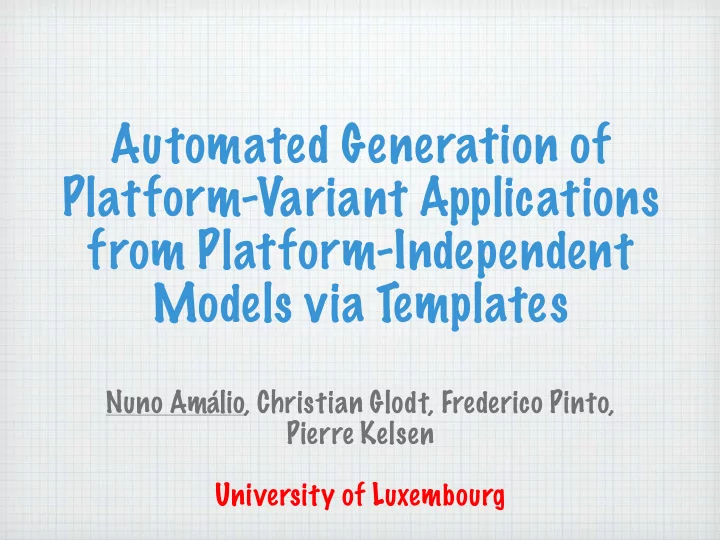

Automated Generation of Platform-Variant Applications from Platform-Independent Models via Templates Nuno Amálio, Christian Glodt, Frederico Pinto, Pierre Kelsen University of Luxembourg
Introduction Manual code development is expensive Platform-diversity: need to support various platforms Not easy to focus on design within code- based development
Talented people may be inspired to create novel applications, but only few have the time, energy and technical skill to dig into the intricacies of low-level programming…
Model-Driven Development Raise level of abstraction from code to models Sw development focused on design Reduce reliance on code experts
Model-Centric approach All platform-code generated from functional models (PIMs) Models are total: structure+behaviour Use of abstraction enables coverage of various platforms Early experimentation from models
Our Approach Product families described as PIMs Platform-specific artifacts generated from templates A catalogue of templates per platform
Our Languages To describe PIMS: visual language EP+OCL To describe Templates: FTL Both languages have formal semantics
EP EP structures models around classes Classes comprise events and properties Details of events described in OCL EP models divided into domains Domains represent different subject matters Domains are linked using bridges
FTL (I) Expresses templates of any target language Generation is based on substitutions We used a java implementation of FTL theory (integrated in Democles)
FTL (II) module JavaClassCat Class == public class 《 ClName 》 { 〚 private 《 propName 》 : 《 propTy 》 ; 〛 〚 ClassMethod 〛 } ∎
FTL (III) public class Book { private title : String; private isbn : String; }
Our Approach EP Modelling and platform-generation framework EP Modelling FTL Platform OCL Translators Mappings EP Model OCL Translator FTL Catalogue of App X for language A for platform A EP Model EP Model OCL Translator FTL Catalogue Mapping for Mapping for for language B for platform B platform A platform B ⋮ ⋮ Legend instantiation Platform A Platform B definition Code for Code for App X App X component
Running Example Simple Library Browser
FTL Template Catalogues Templates / / Catalogue of FTL templates catalogue / / for the Android platform for the module AndroidCat Android import CoreJava import AndroidGUI import AndroidPersistence import JavaStringUtils import AndroidSupport
EP Model
Demonstration…
Evaluation (I) From same EP PIM: iPhone Android generated code for iPhone and Android FTL 1745 1661 Catalogue Platform application Generated 7119 5702 described in terms of Code abstract concepts Could be developed by non-platform experts
Conclusions (I) EP Model is platform-independent Platform-specificity and variability hidden in templates catalogue Not everything describable in OCL Mapping EP Domain define generic events
Conclusions (II) FTL templates provide separate medium over which experts can express their knowledge Use of EP models benefits usability. Templates not so easy to develop Platform catalogues are reusable assets living repository of knowledge
Conclusions (III) Use of EP enables formal model analysis event propagation and animation Experimentation of design decisions using generated code
Future Work Apply approach to larger case study Verification of EP models
Recommend
More recommend